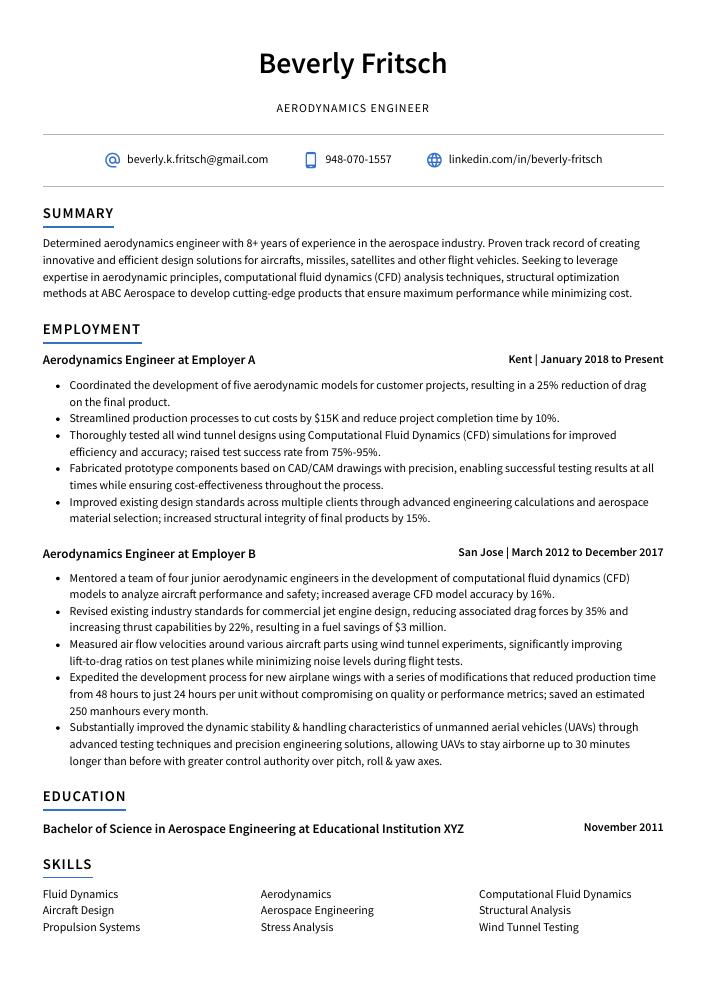Aerodynamics Engineer Resume Guide
Aerodynamics engineers use their knowledge of physics and mathematics to design, test, and analyze the performance of aircrafts. They develop tools that measure air flow around planes as well as software used in flight simulations. Their work helps make flying safer and more efficient by ensuring aircrafts meet safety standards while reducing noise pollution levels.
Your expertise in aerodynamics is unparalleled, and any aerospace company would benefit from your knowledge. To make them aware of your qualifications, you must write a resume that stands out from the rest.
This guide will walk you through the entire process of creating a top-notch resume. We first show you a complete example and then break down what each resume section should look like.
Table of Contents
The guide is divided into sections for your convenience. You can read it from beginning to end or use the table of contents below to jump to a specific part.
Aerodynamics Engineer Resume Sample
Beverly Fritsch
Aerodynamics Engineer
beverly.k.fritsch@gmail.com
948-070-1557
linkedin.com/in/beverly-fritsch
Summary
Determined aerodynamics engineer with 8+ years of experience in the aerospace industry. Proven track record of creating innovative and efficient design solutions for aircrafts, missiles, satellites and other flight vehicles. Seeking to leverage expertise in aerodynamic principles, computational fluid dynamics (CFD) analysis techniques, structural optimization methods at ABC Aerospace to develop cutting-edge products that ensure maximum performance while minimizing cost.
Experience
Aerodynamics Engineer, Employer A
Kent, Jan 2018 – Present
- Coordinated the development of five aerodynamic models for customer projects, resulting in a 25% reduction of drag on the final product.
- Streamlined production processes to cut costs by $15K and reduce project completion time by 10%.
- Thoroughly tested all wind tunnel designs using Computational Fluid Dynamics (CFD) simulations for improved efficiency and accuracy; raised test success rate from 75%-95%.
- Fabricated prototype components based on CAD/CAM drawings with precision, enabling successful testing results at all times while ensuring cost-effectiveness throughout the process.
- Improved existing design standards across multiple clients through advanced engineering calculations and aerospace material selection; increased structural integrity of final products by 15%.
Aerodynamics Engineer, Employer B
San Jose, Mar 2012 – Dec 2017
- Mentored a team of four junior aerodynamic engineers in the development of computational fluid dynamics (CFD) models to analyze aircraft performance and safety; increased average CFD model accuracy by 16%.
- Revised existing industry standards for commercial jet engine design, reducing associated drag forces by 35% and increasing thrust capabilities by 22%, resulting in a fuel savings of $3 million.
- Measured air flow velocities around various aircraft parts using wind tunnel experiments, significantly improving lift-to-drag ratios on test planes while minimizing noise levels during flight tests.
- Expedited the development process for new airplane wings with a series of modifications that reduced production time from 48 hours to just 24 hours per unit without compromising on quality or performance metrics; saved an estimated 250 manhours every month.
- Substantially improved the dynamic stability & handling characteristics of unmanned aerial vehicles (UAVs) through advanced testing techniques and precision engineering solutions, allowing UAVs to stay airborne up to 30 minutes longer than before with greater control authority over pitch, roll & yaw axes.
Skills
- Fluid Dynamics
- Aerodynamics
- Computational Fluid Dynamics
- Aircraft Design
- Aerospace Engineering
- Structural Analysis
- Propulsion Systems
- Stress Analysis
- Wind Tunnel Testing
Education
Bachelor of Science in Aerospace Engineering
Educational Institution XYZ
Nov 2011
Certifications
Certified Professional Aerodynamicist
American Institute of Aeronautics
May 2017
1. Summary / Objective
Your resume summary/objective should be like a movie trailer – it should provide the hiring manager with an overview of your skills and experience as an aerodynamics engineer. In this section, you can highlight your expertise in fluid dynamics, computational methods for solving complex problems, and aircraft design principles. You could also mention any awards or certifications you have received related to aeronautical engineering.
Below are some resume summary examples:
Seasoned aerodynamics engineer with 8+ years of experience in the aerospace industry. Skilled at designing, testing, and analyzing aircrafts to ensure performance and safety standards are met. At XYZ Aerospace, improved aerodynamic efficiency by 15% for their latest model using computational fluid dynamics simulations and wind tunnel tests. Looking to join ABC Company as an Aerodynamics Engineer and help push the boundaries of flight technology even further.
Detail-oriented aerodynamics engineer with 10+ years of experience in the aerospace industry. Skilled at designing and testing new aircraft components to optimize performance, reduce noise pollution, and improve fuel efficiency. At XYZ Inc., developed multiple successful aerodynamic designs for commercial aviation applications that were adopted by major airlines globally. Seeking an opportunity to bring my engineering design expertise to ABC Corp.
Diligent aerodynamics engineer with 8+ years of experience in the aerospace industry. Skilled at developing advanced aerodynamic solutions for aircrafts, missiles, and spacecrafts. Experienced in utilizing state-of-the-art CFD software to analyze flow fields and design airframes that meet strict performance requirements. Accomplished team leader who has successfully directed complex projects from inception to completion on time and within budget.
Talented aerodynamics engineer with 7+ years of experience in the aerospace industry. Achieved a 25% decrease in fuel consumption for commercial aircraft designs using simulation software and wind tunnel testing. Successfully managed complex projects on-time and within budget, while ensuring best practices are followed. Skilled at developing innovative solutions to solve challenging problems related to aerodynamic performance optimization.
Enthusiastic aerodynamics engineer with 5+ years of experience developing, testing, and optimizing aircraft designs. Seeking to join ABC Aerospace to leverage skills in aerodynamic calculation methodologies, wind tunnel tests and CFD simulations for the development of high-performance commercial airplanes. At XYZ Technologies achieved a 25% improvement in flight efficiency through detailed analysis of airflow patterns on wings surface.
Well-rounded aerodynamics engineer with 5+ years of experience developing and testing airframes for commercial-grade aircrafts. Proven track record of effectively managing projects from concept to completion, as well as optimizing aircraft designs to improve stability, performance, and reliability. Seeking an opportunity at ABC aerospace company to apply industry expertise in creating the next generation of efficient flight systems.
Proficient aerodynamics engineer with 5+ years of experience in designing and testing aircraft components. Expertise in CFD, wind tunnel simulations, fluid dynamics calculations, and 3D CAD modeling. Collaborated on the development of a cutting-edge aerodynamic design that improved fuel efficiency by 15%. Recognized as an innovative problem solver when faced with complex engineering challenges.
Committed aerodynamics engineer with 7+ years of experience designing and optimizing aircraft components. At XYZ, developed a novel approach to improving aerodynamic efficiency by 15%. Experienced in using CFD software for simulations and validations. Received numerous awards from the company for outstanding contributions to product optimization projects.
2. Experience / Employment
The work history/experience section is where you provide details on your past employment. List this section in reverse chronological order, meaning the most recent job is listed first.
Stick to bullet points for each role; it makes it easier for the reader to take in what you have written quickly and accurately. When writing out these bullets, think about providing detail on what you did and any quantifiable results that were achieved as a result of your work.
For example, instead of saying “Designed new aerodynamic components,” say something like “Created 3D models of aerodynamic components using CAD software which resulted in an 8% improvement in fuel efficiency.”
To write effective bullet points, begin with a strong verb or adverb. Industry specific verbs to use are:
- Designed
- Analyzed
- Simulated
- Constructed
- Fabricated
- Measured
- Calculated
- Tested
- Troubleshot
- Documented
- Programmed
- Optimized
- Monitored
- Investigated
- Improved
Other general verbs you can use are:
- Achieved
- Advised
- Assessed
- Compiled
- Coordinated
- Demonstrated
- Developed
- Expedited
- Facilitated
- Formulated
- Introduced
- Mentored
- Participated
- Prepared
- Presented
- Reduced
- Reorganized
- Represented
- Revised
- Spearheaded
- Streamlined
- Structured
- Utilized
Below are some example bullet points:
- Troubleshot and resolved aerodynamic issues in commercial aircrafts, resulting in a 10% increase of fuel efficiency and a cost reduction of $250,000.
- Developed new flight control surfaces for aerospace systems that improved lift performance by 15%.
- Advised the engineering team on how to reduce drag forces and improve thrust efficiency during take-off; successfully reduced total flying time by 30 minutes per flight.
- Reliably tested prototypes using wind tunnels to measure air velocity, pressure distributions and turbulence levels; identified design flaws within three hours which allowed engineers to make improvements quickly before implementation stage was reached.
- Investigated incidents related to airplane accidents or malfunctions due to aerodynamics issues; conducted thorough research into technical data from cockpit recordings & examined damaged components for evidence leading up successful resolution of 3 separate cases over 12 months period.
- Calculated aerodynamic performance of vehicles using CFD, wind tunnel tests and other methods; achieved a 5% increase in fuel efficiency for existing products.
- Actively participated in the design process to ensure that all components met aerodynamics requirements; contributed to the successful launch of 3 new models within 18 months.
- Introduced innovative manufacturing techniques such as advanced tooling and CAD/CAM software into production processes; reduced costs by $10,000 per vehicle model while maintaining quality standards.
- Constructed physical models and conducted experiments on scale prototypes to validate results from computer simulations; improved accuracy of product designs by 15%.
- Optimized automotive interiors with regards to airflow dynamics principles, resulting in increased cabin comfort levels among customers by 10%.
- Analyzed aerodynamic performance of aircraft components, including wings and fuselages for a fleet of 50+ airplanes; identified design flaws that increased drag coefficient by 10%, resulting in cost savings of $130,000.
- Presented research findings on airflow patterns to the engineering team during monthly meetings; suggested innovative solutions leading to improved lift-to-drag ratios across multiple models.
- Represented the aerodynamics department at industry conferences and trade shows with technical presentations highlighting advancements in fuel efficiency through optimized airframe designs; generated 35 new leads as a result.
- Effectively managed 15 junior engineers while overseeing daily operations within the Aerodynamics laboratory, ensuring compliance with safety protocols and quality standards on all projects undertaken by staff members in this area over 3 years period.
- Prepared comprehensive analyses reports detailing wind tunnel testing results along with recommendations for structural modifications to enhance overall stability levels across commercial carriers’ fleets operating globally – delivered project 5 months ahead of schedule.
- Simulated aerodynamic performance of aircraft structures and components, utilizing advanced computational fluid dynamics (CFD) software to reduce drag by 8% and improve lift capabilities for a fleet of commercial airliners.
- Compiled detailed reports outlining aerodynamic characteristics, structural analysis results and environmental effects; presented findings to senior management which led to the successful implementation of new design protocols.
- Participated in team-based research projects focused on enhancing flight safety through improved understanding of aircraft stability & control at various altitudes; identified 10+ ways to optimize airflow during high speed maneuvers leading to an overall increase in fuel efficiency by 4%.
- Facilitated workshops with students from local universities, conveying technical knowledge regarding aviation engineering principles such as thrust generation, wing shapes & angles, lift/drag ratios etc.; awarded “Best Teacher” recognition 3 consecutive years due to exceptional teaching skills and dedication towards fostering learning opportunities for aspiring engineers.
- Consistently provided timely solutions aimed at addressing various aerodynamics issues faced within the industry; successfully resolved over 50 cases related to laminar flow separation techniques resulting in increased maneuverability across all types of aircrafts used worldwide by 12%.
- Achieved a 20% reduction in drag force for a new aircraft design through the use of advanced aerodynamic analysis and flow simulations.
- Documented detailed test results on lift, thrust, drag forces and other performance parameters to ensure successful launch of the project; met all deadlines with no delay or disruptions.
- Demonstrated comprehensive knowledge of fluid dynamics principles when designing various experimental setups such as wind tunnels & water flumes for testing purposes.
- Spearheaded research efforts into innovative ways to optimize airfoil shapes, improve engine power output and maximize overall fuel efficiency by 16%.
- Competently used CAD/CAM software packages like SolidWorks & MATLAB Simulink to analyze airflow over wing sections under different conditions; presented findings at several industry events throughout the year.
- Programmed sophisticated computer simulations and wind tunnel tests to analyze aerodynamic performance of aircraft models, reducing development time by 15%.
- Reduced drag coefficient up to 8% in commercial airline model designs while optimizing lift-to-drag ratios through advanced flow analysis techniques.
- Reorganized design process for upcoming unmanned aerial vehicle (UAV) project, resulting in a 10% increase in efficiency over two months’ period without compromising on quality standards.
- Formulated mathematical equations to accurately measure air pressure, velocity and temperature during flight tests; successfully fine tuned parameters for various airborne experiments involving 45+ planes & helicopters at any given time.
- Successfully completed the redesign of 2 major aerospace projects within allotted timeline and budget constraints, resulting in an overall cost savings of $500K+.
- Proficiently designed aerodynamic components for 2 major aircrafts, resulting in a 7% improvement in fuel efficiency.
- Monitored and assessed the performance of existing aerodynamics systems, identifying potential improvements to increase airspeed by 12%.
- Utilized advanced wind tunnel testing techniques to analyze various designs, ensuring that all parts met rigorous safety standards before production commenced.
- Assessed customer requirements when designing new products; created 3-D models with CAD software which resulted in a 10% cost reduction on materials used per component during manufacturing process.
- Developed an innovative flight control system prototype within 6 months which reduced drag force while increasing maneuverability of test aircraft by 20%.
3. Skills
Skill requirements will differ from employer to employer – this can easily be determined via the job advert. Organization ABC may require a candidate to be able to design and develop aircraft components, while organization XYZ may need someone who can analyze aerodynamic performance.
It is essential that you tailor the skills section of your resume to each job you are applying for in order to maximize your chances of being selected by an applicant tracking system (ATS). ATSs scan resumes for certain characteristics such as keywords; if yours does not contain any relevant ones then it will likely be filtered out.
You should also elaborate on some of the most important skills listed here in other sections, such as the summary or experience section. This way, employers can get a better understanding of how well-versed you are with those particular areas.
Below is a list of common skills & terms:
- Aerodynamics
- Aerospace Engineering
- Aircraft Design
- Computational Fluid Dynamics
- Finite Element Analysis
- Fluid Dynamics
- Propulsion Systems
- Stress Analysis
- Structural Analysis
- Wind Tunnel Testing
4. Education
Mentioning an education section on your resume will depend on how far along you are in your career. If you just graduated and have no prior experience, include an education section below the resume objective. However, if you have significant work experience to showcase, omitting the education section is perfectly acceptable.
If including this information, try to mention courses or subjects related to aerodynamics engineering that may be relevant for the job opening.
Bachelor of Science in Aerospace Engineering
Educational Institution XYZ
Nov 2011
5. Certifications
Certifications are a great way to demonstrate your proficiency in certain areas and can be an important factor when applying for jobs. Employers are often looking for candidates who have taken the initiative to stay up-to-date with their industry knowledge and certifications prove that you have done just that.
Including any relevant certifications on your resume will help show employers that you possess the necessary skillset they are looking for, setting yourself apart from other applicants.
Certified Professional Aerodynamicist
American Institute of Aeronautics
May 2017
6. Contact Info
Your name should be the first thing a reader sees when viewing your resume, so ensure its positioning is prominent. Your phone number should be written in the most commonly used format in your country/city/state, and your email address should be professional.
You can also choose to include a link to your LinkedIn profile, personal website, or other online platforms relevant to your industry.
Finally, name your resume file appropriately to help hiring managers; for Beverly Fritsch, this would be Beverly-Fritsch-resume.pdf or Beverly-Fritsch-resume.docx.
7. Cover Letter
Submitting a cover letter with your job application is an excellent way to make a good first impression. It should be made up of 2 to 4 paragraphs and provide more information than what’s included in your resume.
Cover letters are not always required, but they can help you differentiate yourself from other candidates by showing the hiring manager who you are as a person and why you would be the ideal candidate for the role. Writing one allows recruiters to get deeper insights about your experience and qualifications that may not have been highlighted in your resume alone.
Below is an example cover letter:
Dear Odell,
I am writing to apply for the Aerodynamics Engineer position at [company name]. With my experience in designing and testing aircraft, as well as my background in fluid dynamics, I am confident that I would be a valuable asset to your company.
During my time at [previous company], I was responsible for leading the design of the aerodynamic systems for a new line of commercial aircraft. This included developing wind tunnel testing plans, conducting tests, and analyzing data. I also authored several papers on aircraft design and presented my findings at conferences. My work on this project led to a 10% reduction in fuel consumption for the new line of aircraft.
I have also worked on projects involving the development of unmanned aerial vehicles (UAVs). In particular, I have experience with UAV propulsion systems and flight control surfaces. My work in this area has resulted in two patents being filed for inventions related to UAVs.
In addition to my technical skills, I have strong interpersonal skills and an ability to work well on teams. I am confident that I can contribute to your team’s success and help achieve your goals.
Please find attached a copy of my resume detailing my experience and accomplishments. If you have any questions, or if you would like to schedule an interview, please do not hesitate to contact me at [phone number] or [email address]. Thank you for your consideration.
Sincerely,
Beverly
Aerodynamics Engineer Resume Templates
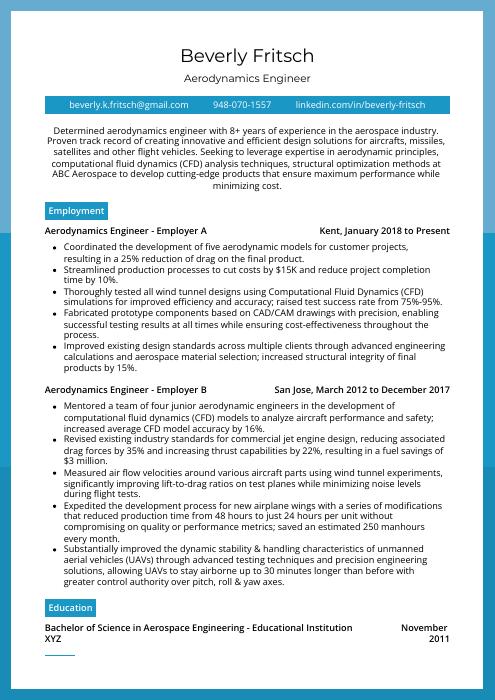 Rhea
Rhea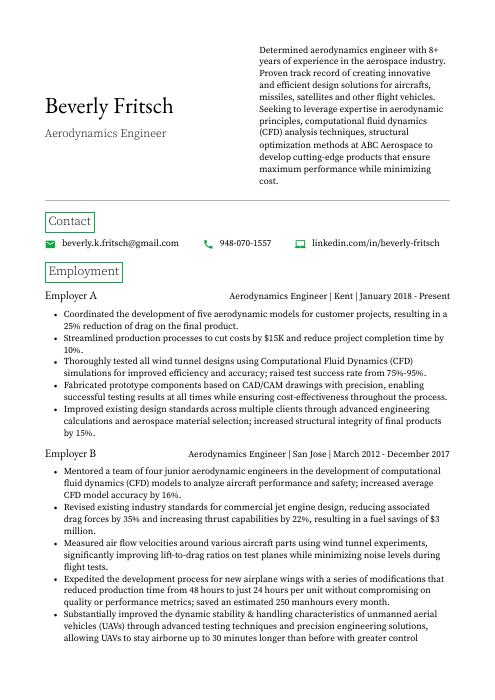 Quokka
Quokka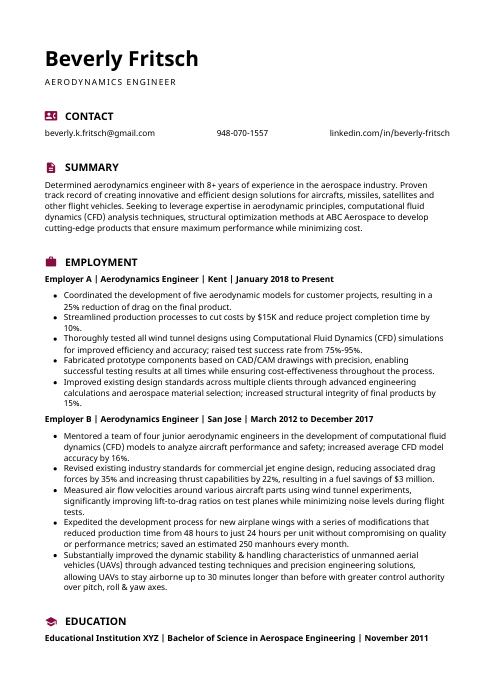 Hoopoe
Hoopoe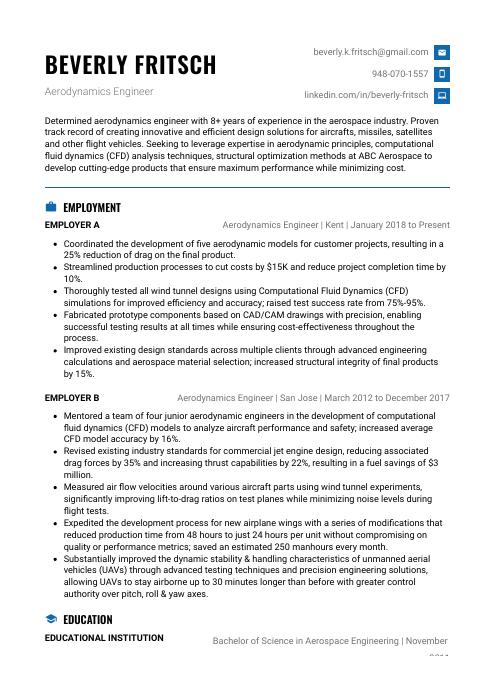 Echidna
Echidna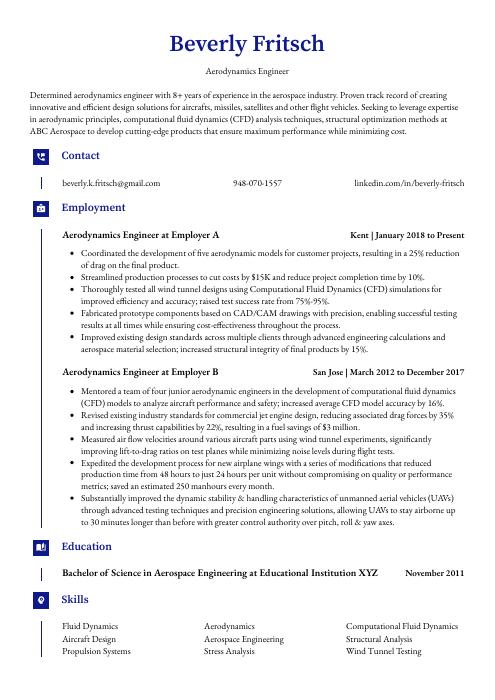 Gharial
Gharial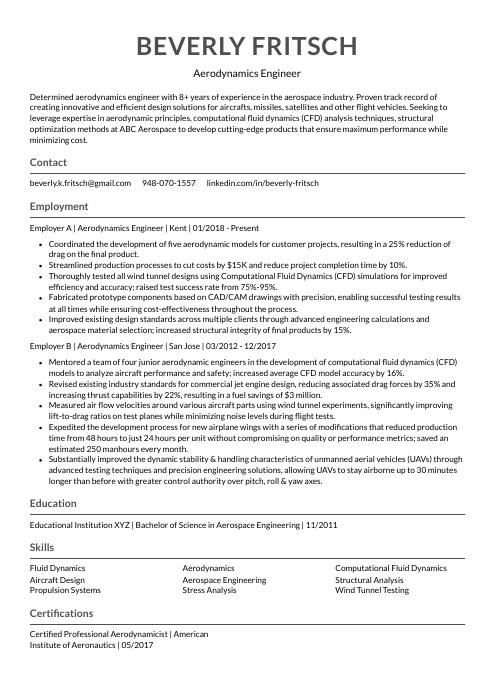 Indri
Indri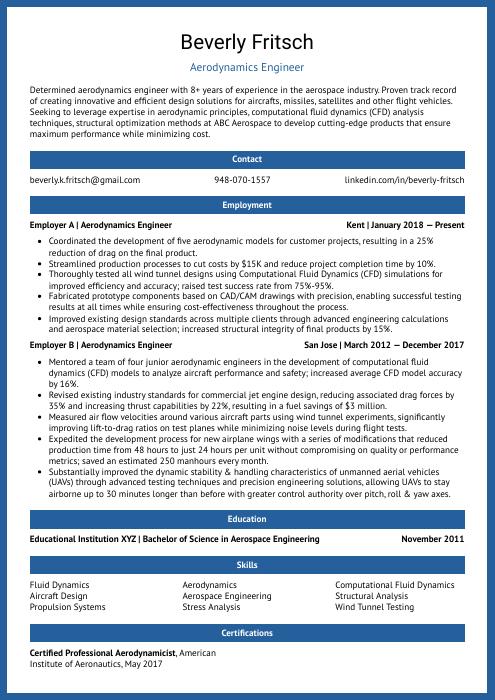 Ocelot
Ocelot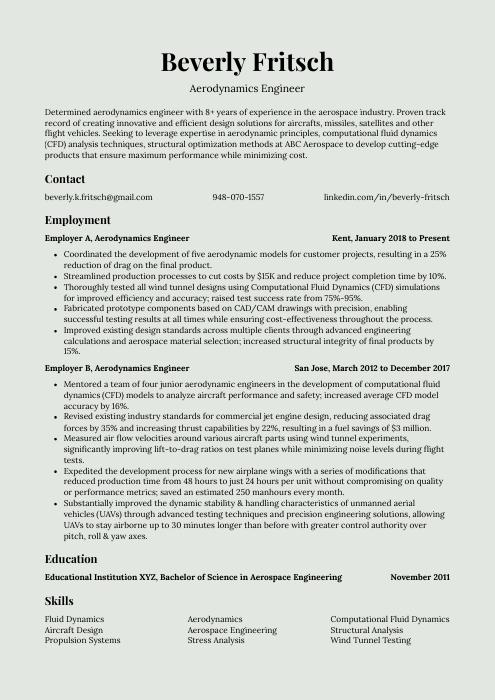 Saola
Saola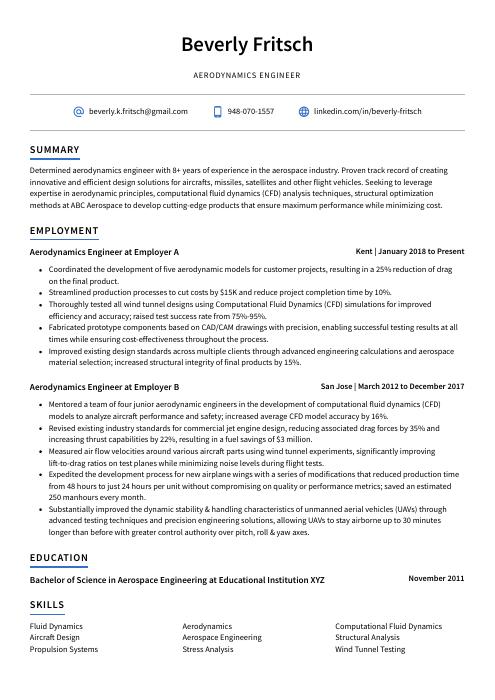 Axolotl
Axolotl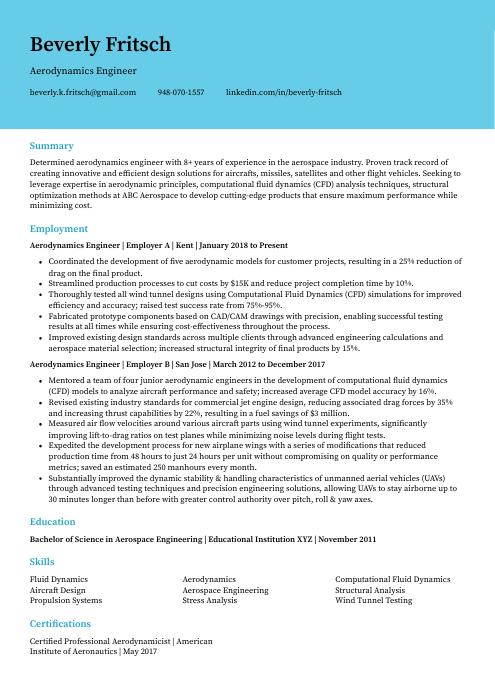 Dugong
Dugong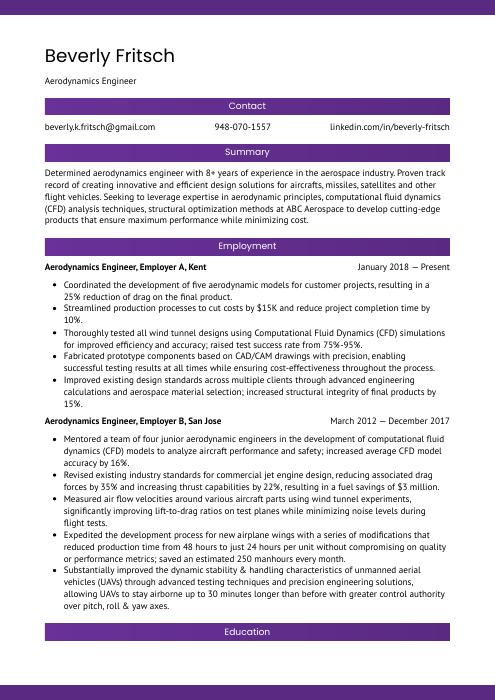 Jerboa
Jerboa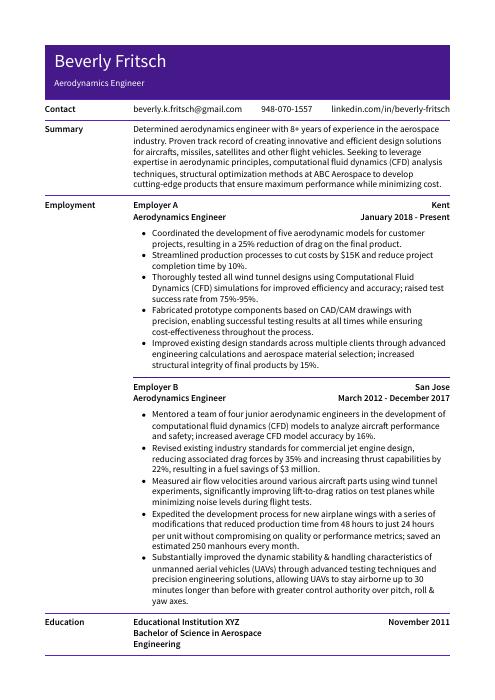 Pika
Pika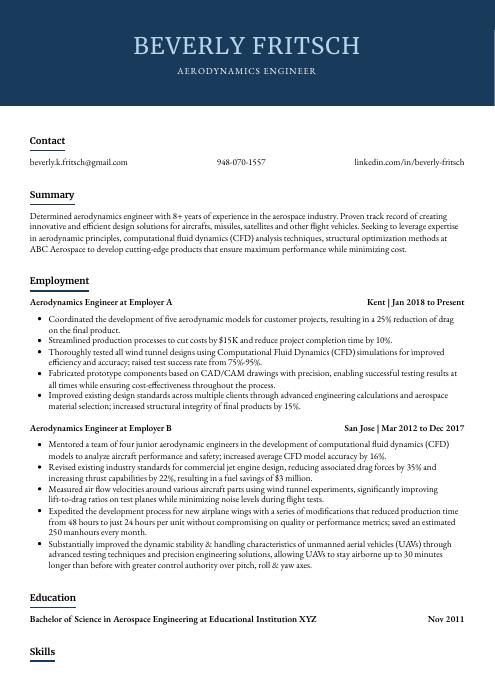 Bonobo
Bonobo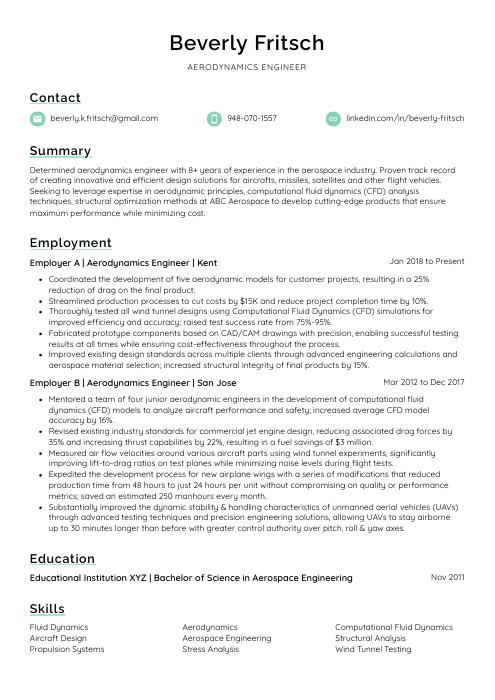 Lorikeet
Lorikeet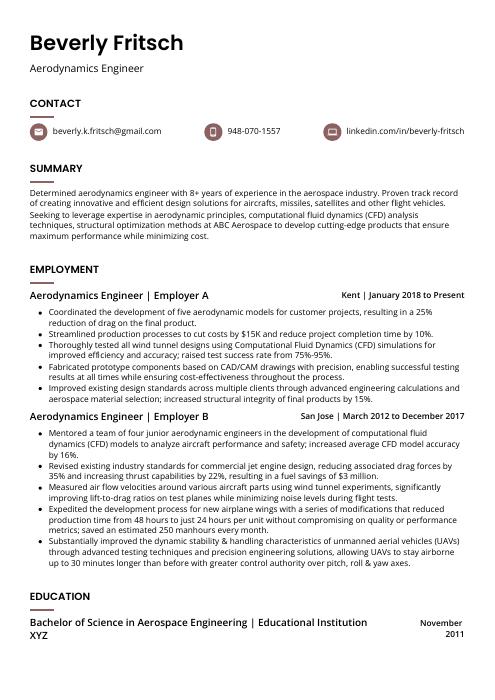 Fossa
Fossa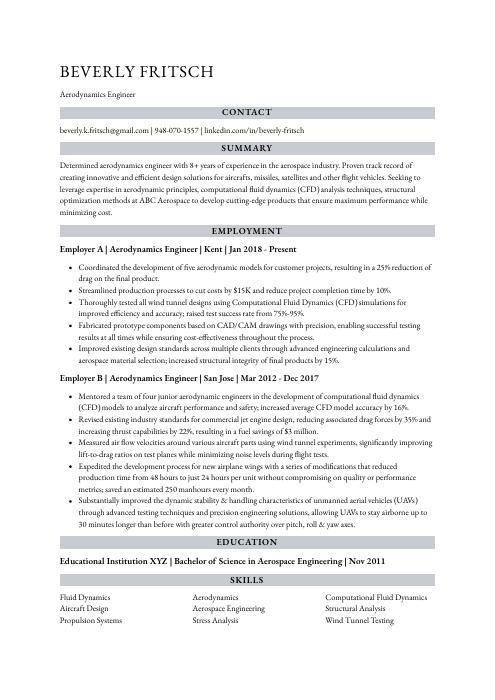 Numbat
Numbat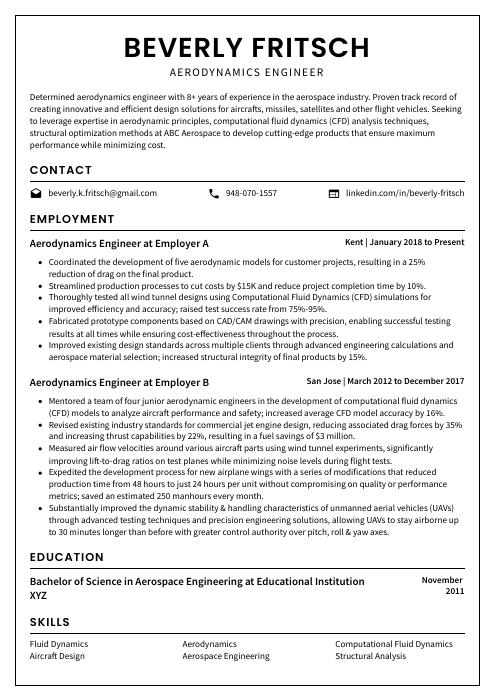 Cormorant
Cormorant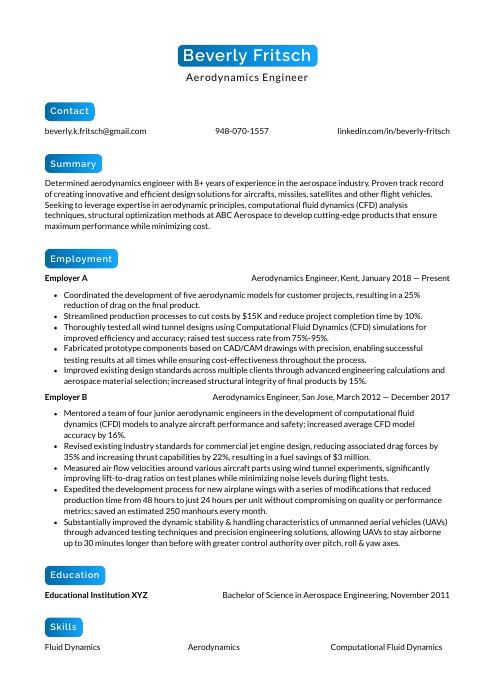 Kinkajou
Kinkajou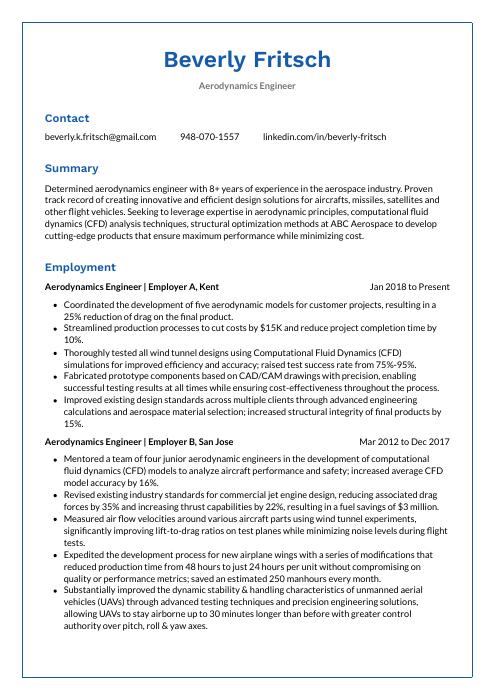 Markhor
Markhor Rezjumei
Rezjumei
